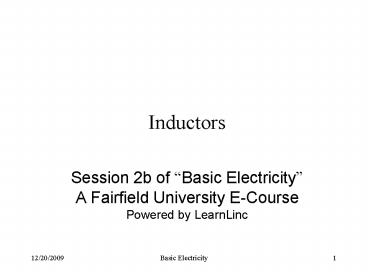Inductors - PowerPoint PPT Presentation
1 / 19
Title:
Inductors
Description:
... of Electricity Lessons One and Two,' SNET Home Study Coordinator, (203) 771-5400 ... 09. Basic Electricity. 15. Time Constant. Time constant = L/R. Formula ... – PowerPoint PPT presentation
Number of Views:742
Avg rating:3.0/5.0
Title: Inductors
1
Inductors
- Session 2b of Basic ElectricityA Fairfield
University E-CoursePowered by LearnLinc
2
Basic Electricity
- Two Sections
- Electron Flow and Resistance
- 5 on-line sessions
- Lab
- Inductance and Capacitance
- 5 on-line sessions
- Lab
- Mastery Test, Part 1
3
Basic Electricity(Continued)
- Text Electricity One-Seven, Harry
Mileaf, Prentice-Hall, 1996, ISBN 0-13-889585-6
(Covers several Modules and more) - References
- Digital Mini Test Principles of Electricity
Lessons One and Two, SNET Home Study
Coordinator, (203) 771-5400 - Electronics Tutorial (Thanks to Alex Pounds)
- Electronics Tutorial (Thanks to Mark Sokos)
- Basic Math Tutorial (Thanks to George Mason
University) - Vector Math Tutorial (Thanks to California
Polytec at atom.physics.calpoly.edu )
4
Section 2 AC, Inductors and Capacitors
- 0BJECTIVES This section introduces AC voltage /
current and additional circuit components
(inductors, transformers and capacitors).
5
Section 2 Schedule
Text 3.1 3.41Text 4.1 4.24 Text 3.42
3.73Text 3.74 3.100Text 3.101
3.135Text 3.135 3.148
Alternating Current Sine WavesSine Waves,
Magnitude, Phase and VectorsInductors and
CircuitsTransformersCapacitorsMore
CapacitorsReview (Discuss Quiz_2)
Session 2a 03/27Vector Math 04/01
Session 2b 04/03(fri. review session?)
Session 2c 04/08Session 2d 04/10
(lab - 04/13, Sat.) Session 2e
04/15Session 2f 04/22
6
Vector Session Review
- Sine waves sin(2?ft?)
- Frequency (f)
- Period Wavelength (?)
- Amplitude (A)
- Phase (?)
- Sin and Cos
- Adding sine waves
- Vector analogy
- Magnitude and Angle
- Addition
- Head-to-Tail
- Parallelogram
- Components (Later)
7
EMF and Current
- a. No applied voltage no current
- b. Constant applied voltage linearly
increasing current - c. Zero applied voltage unchanging current
- d. Negative applied voltage linearly
decreasing current - e. no applied voltage no current
a
b
c
d
e
8
Frequency Effects
- To get the same effect from low frequency AC
current, you need a higher current
9
EMF Polarity vs. Applied Voltage
- Induced EMF always opposes voltage applied across
the inductor
10
Coiling to Increase Inductance
- Coiling a wire increases its inductance
- Magnetic fields from each loop support each other
(mutual inductance)
11
Resistors vs. Inductors
- Analogy to Ohms law for resistors
- Inductors resist changes in their current with
their Reactance
12
Real Inductors
13
Factors Affecting Inductance
14
Inductor Transient Current
- DC applied to a series resistor and inductor
circuit - At t0 inductor has a high reactance so no
current - After a while the inductor behaves like a short
circuit - The current rises exponentially from 0 to V/R
- If the battery then drops top zero the reverse
happens
15
Time Constant
- Time constant? L/R
- FormulaI 1-?-(t/?)? 2.7818(base of the
natural logarithm)
16
AC Voltage and Current
- Induced EMF opposes applied voltage
- Inductor current lags the voltage 90(Eli the
ice man) - Inductor Reactance (XL 2?fL) determines the
current magnitude ( I V / XL )
17
Series and Parallel Inductors
18
Q
- Quality factor Q of a coil is defined as the
energy stored divided by the energy lost - Wire resistance
- Losses in the core
- Calculating Q of an InductorQ XL / Reff
19
Section 2 Schedule
Text 3.1 3.41Text 4.1 4.24 Text 3.42
3.73Text 3.74 3.100Text 3.101
3.135Text 3.135 3.148
Alternating Current Sine WavesSine Waves,
Magnitude, Phase and VectorsInductors and
CircuitsTransformersCapacitorsMore
CapacitorsReview (Discuss Quiz_2)
Session 2a 03/27Vector Math 04/01
Session 2b 04/03(fri. review
session?)Session 2c 04/08Session 2d
04/10 (lab - 04/13, Sat.) Session 2e
04/15Session 2f 04/22































